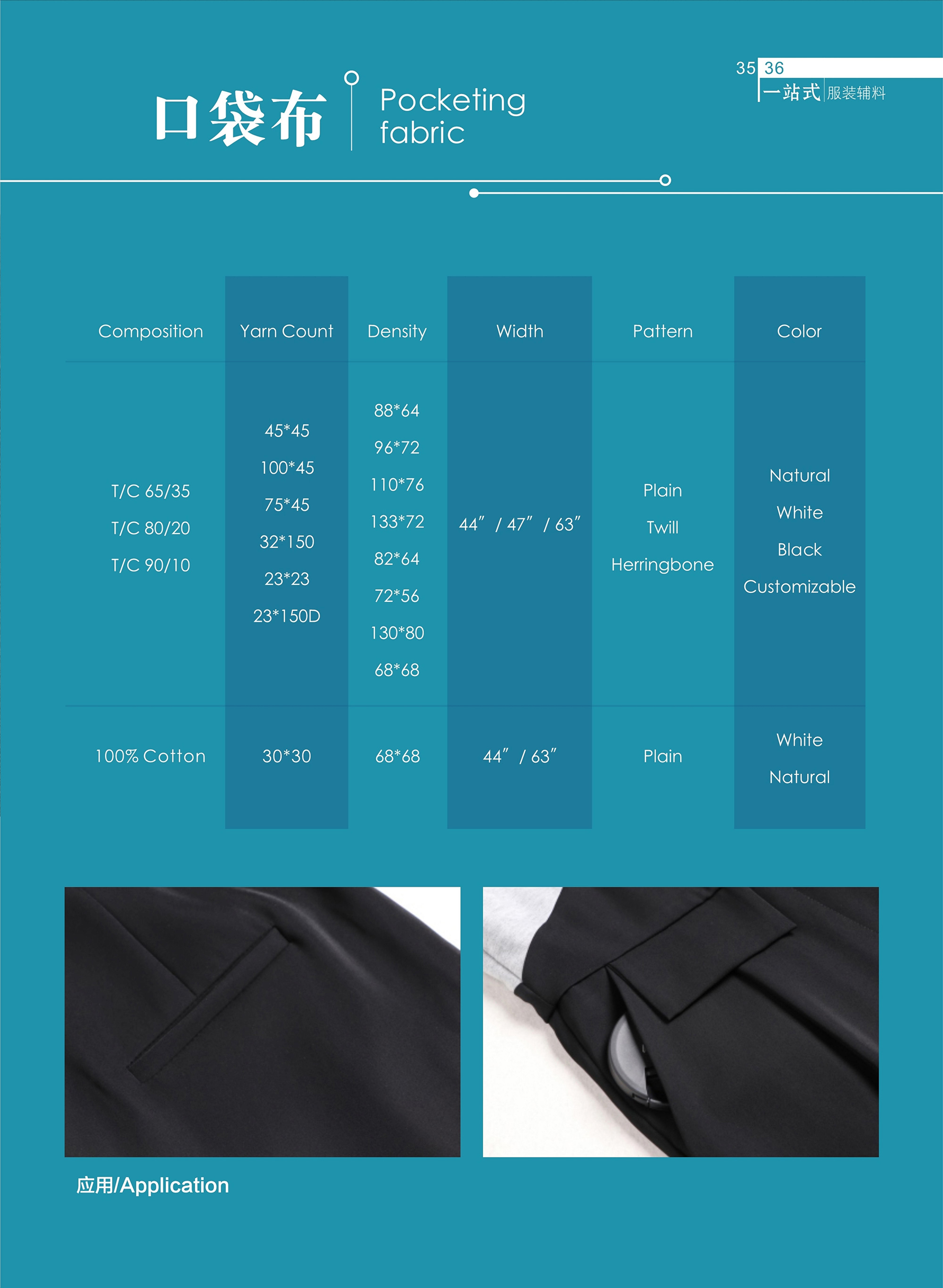Pocketing Fabric refers to the material used to construct the pockets inside garments such as trousers, jackets, skirts, and dresses. This fabric is chosen for its durability, smooth texture, and ability to withstand the wear and tear associated with regular use of pockets.
Material:
- Cotton: A common choice for pocketing fabric due to its breathability, softness, and durability. Cotton pocketing can come in various weights and finishes, such as twill, poplin, or plain weave, depending on the garment's needs.
- Polyester: Often blended with cotton or used on its own, polyester pocketing fabric offers increased strength, wrinkle resistance, and moisture-wicking properties. It is a durable, cost-effective option that also resists shrinking and stretching.
- Poly-Cotton Blend: A blend of polyester and cotton, this fabric combines the best properties of both fibers, offering a balance of durability, comfort, and cost-effectiveness. The polyester adds strength and wrinkle resistance, while the cotton provides softness and breathability.
- Nylon: Lightweight and highly durable, nylon pocketing fabric is often used in activewear or outerwear where strength and moisture resistance are important.
- Rayon: A smooth, lightweight fabric that adds a luxurious feel to pockets, often used in higher-end garments. Rayon is breathable and drapes well, but it may not be as durable as other options.
- Taffeta: A crisp, smooth fabric often made from silk, polyester, or nylon. Taffeta pocketing fabric is commonly used in suits and tailored garments for its fine finish and slight sheen.
Characteristics:
- Durability: Pocketing fabric must be strong enough to withstand the friction and stress of daily use. Fabrics like cotton twill, poly-cotton blends, and nylon are favored for their toughness.
- Smooth Texture: A smooth surface is essential to prevent items from catching on the fabric when placed in or removed from pockets. Pocketing fabrics are typically woven tightly to ensure a smooth finish.
- Lightweight: The fabric should be lightweight to avoid adding bulk to the garment, ensuring that the pockets are functional without affecting the garment's drape or fit.
- Breathability: Especially important in garments like trousers, breathable pocketing fabric helps maintain comfort by allowing air circulation, which reduces sweating and discomfort.
- Shrink Resistance: Since pocketing fabric is often exposed to regular washing, it needs to be resistant to shrinking to maintain the pocket's shape and size over time.
- Color Fastness: Pocketing fabric should retain its color after multiple washes, ensuring that the pocket interiors do not fade or bleed onto the outer fabric.
Applications:
- Trousers and Pants: Pocketing fabric is commonly used in the construction of side pockets, back pockets, and coin pockets in trousers and pants. Durability and breathability are key considerations in these garments.
- Jackets and Blazers: In jackets and blazers, pocketing fabric is used for internal breast pockets, side pockets, and ticket pockets. A smoother, more luxurious fabric like rayon or taffeta might be used in higher-end garments.
- Skirts and Dresses: Pocketing fabric in skirts and dresses is usually lightweight and smooth to maintain the garment's silhouette and comfort.
- Outerwear: For coats, parkas, and other outerwear, pocketing fabric is often chosen for its durability and moisture resistance, with materials like nylon or polyester being common.
- Bags and Accessories: Pocketing fabric is also used in bags and accessories, providing a sturdy lining for compartments and pockets to protect the contents and add structure to the design.
How to Use:
-
Cutting: Pocketing fabric is cut according to the pocket pattern pieces provided in the garment's design. Precision in cutting ensures that the pocket fits properly within the garment without adding bulk or distorting the shape.
-
Sewing: The pocketing fabric is sewn to the garment's outer fabric, typically along the side seams, waistbands, or inside the lining. Double stitching or overlocking may be used to reinforce the seams and prevent fraying.
-
Finishing: After the pockets are sewn, the edges are often finished with overlocking or binding to prevent fraying and ensure a clean, durable edge.
-
Pressing: The pockets are pressed flat to ensure they lie smoothly within the garment, contributing to a polished final appearance.
Advantages:
- Enhanced Durability: Using high-quality pocketing fabric ensures that pockets can withstand the stress of regular use, extending the life of the garment.
- Comfort: Soft and breathable pocketing fabrics add comfort to the garment, preventing irritation and allowing for better airflow.
- Improved Functionality: Lightweight, durable pocketing fabric ensures that pockets remain functional without adding unnecessary bulk, maintaining the garment's intended fit and silhouette.
- Aesthetic Appeal: Choosing the right pocketing fabric can enhance the overall quality and appearance of the garment, particularly in high-end or tailored clothing.
Considerations:
- Matching Fabric Properties: The pocketing fabric should complement the outer fabric in terms of weight and drape to ensure that it integrates seamlessly into the garment.
- Color Matching: While pocketing fabric is often hidden, it's important to choose a color that doesn’t bleed through or alter the appearance of the garment, particularly in light-colored fabrics.
- Cost: Higher-quality pocketing fabrics like taffeta or rayon may increase the cost of the garment but can significantly enhance the garment’s quality and longevity.
In summary, pocketing fabric is an essential element in garment construction, chosen for its durability, comfort, and ability to enhance the overall functionality of pockets. Whether in casual pants, tailored jackets, or high-end dresses, the right pocketing fabric ensures that the garment is both practical and comfortable, with pockets that stand up to daily use while maintaining the garment’s intended fit and appearance.


 CN
CN Contact Us
Contact Us



